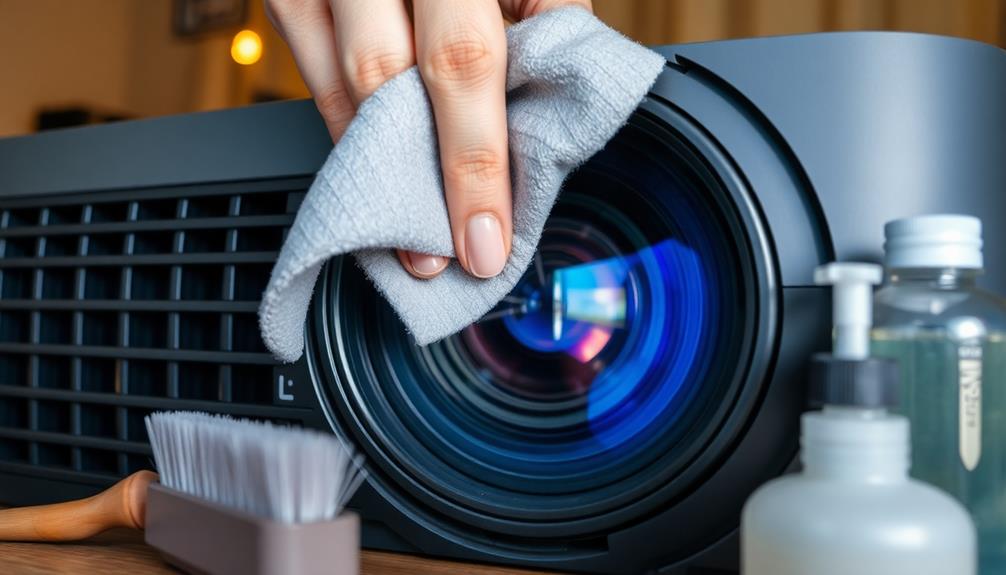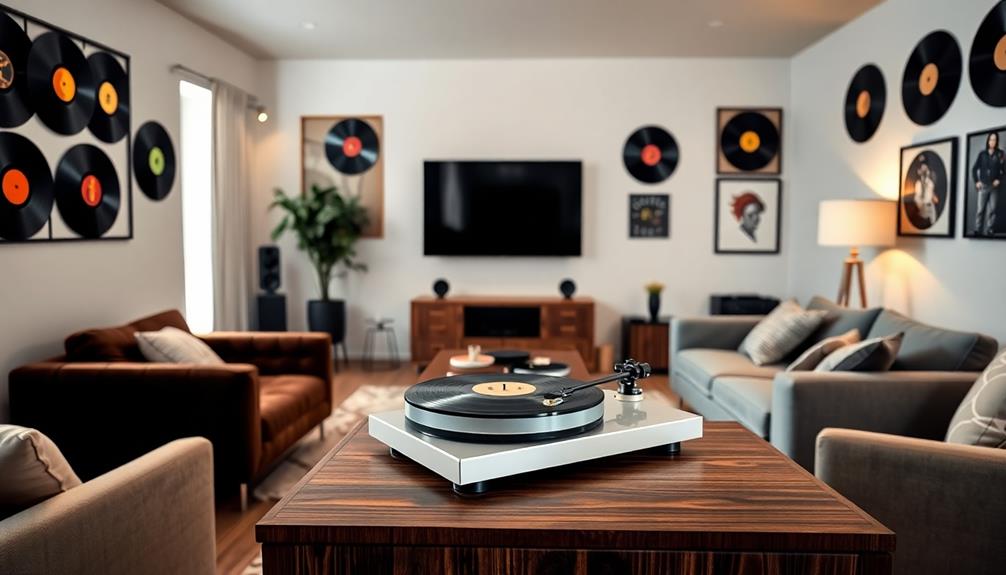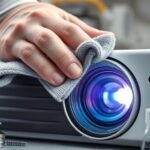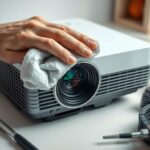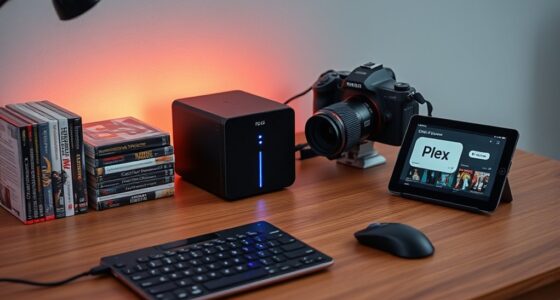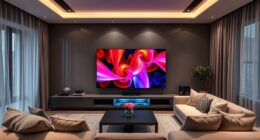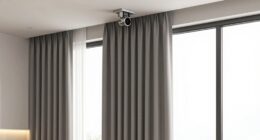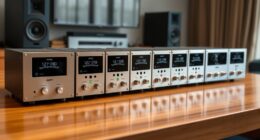To keep your home cinema projector crystal clear, regular maintenance is essential. Start by cleaning the lens with a soft, lint-free cloth to avoid blurry images. Remember to clean vents and filters every 3-6 months to guarantee proper airflow. The right environment helps too; consider a no-shoes policy and use air purifiers to reduce dust. Monitor your lamp life and turn off the projector when not in use to extend its longevity. Professional servicing can also enhance performance and catch potential issues early. With these tips, you'll create a stunning viewing experience that's worth exploring further.
Key Takeaways
- Regularly clean the projector lens and vents every 3-6 months to maintain brightness and prevent overheating.
- Implement a no-shoes policy and utilize air purifiers to minimize dust accumulation in your home theater.
- Ensure proper ventilation around the projector to enhance performance and prolong its lifespan.
- Monitor lamp usage and engage Eco mode to extend lamp life and reduce energy consumption.
- Consider professional servicing annually for thorough cleaning and maintenance to optimize projector functionality.
Importance of Regular Cleaning
Regular cleaning of your projector is crucial for maintaining its performance and extending its lifespan. Dust accumulation can greatly impact your viewing experience, reducing brightness by up to 40% over five years.
To guarantee peak performance, regularly check and clean the projector lens using a soft, lint-free cloth. This simple step prevents blurriness caused by fingerprints and dust, allowing for clear and vibrant images during your movie nights. Additionally, maintaining a clean environment can enhance air quality, similar to how a good air purification system improves indoor air quality.
Don't forget about the vents and filters! Cleaning these every 3-6 months promotes better airflow, which is essential for cooling your projectors. If airflow is restricted, overheating can occur, potentially leading to premature component failure. Keeping filters clean helps trap dust effectively, enhancing overall projector performance.
You can also adopt a no-shoes policy in your home theater to minimize dirt entry. This strategy not only reduces the need for frequent cleaning but also helps maintain a dust-free environment for your projectors.
Ensuring Proper Ventilation
How can you guarantee your projector remains in top shape? Making sure proper ventilation is essential. Heat is a significant enemy of projectors, and if airflow is obstructed, it can lead to reduced performance and a shorter lifespan.
To avoid these issues, place your projector in well-ventilated areas, steering clear of tight spaces or walls that trap heat.
Here are some tips to maintain proper ventilation:
- Regularly check the functionality of your projector's fans to make certain they're promoting adequate airflow.
- Clean vents and filters every 3-6 months to prevent dust buildup—remember, dust is the enemy.
- Maintain unobstructed airflow around your projector for peak performance.
Safe Handling Practices
When you're done using your projector, make sure to let it cool down for at least 30 minutes before moving it to avoid burns and damage.
Always transport it in a protective case to shield it from physical impacts and environmental hazards.
Remember to handle the bulbs with care, as touching the glass can reduce their lifespan considerably.
Allow Cooling Before Moving
Allowing your projector to cool down before moving is essential for maintaining its longevity and performance.
After use, always wait at least 30 minutes for the projector to cool. This practice prevents damage to sensitive internal components, especially the lamp and mechanisms.
Projector bulbs can reach extremely high temperatures, and moving a hot projector can lead to burns or internal damage due to thermal shock.
Here are some key reasons to allow cooling:
- Protect internal components: Prevent misalignment that could affect performance.
- Ensure image quality: Avoid costly repairs and maintain ideal viewing experiences.
- Reduce overheating risks: Regularly check cooling fans for better efficiency.
Use Protective Cases
After ensuring your projector has cooled down, it's time to think about its protection during transportation and storage. Using protective cases is essential to safeguard your projector from physical damage and impacts, especially when you're moving between locations.
Make sure the case you choose is designed specifically for your projector model. A snug fit will prevent movement inside the case, reducing the risk of damage to the projector's lens. Additionally, consider choosing a case that's lightweight yet durable, as this can make transporting your projector easier while still providing optimal protection for your investment.
When you're not using your projector, always store it in a protective case to shield it from dust, moisture, and scratches. Dust can accumulate and affect performance, while moisture can lead to internal damage.
Regularly inspect your protective case for wear and tear; a damaged case won't provide adequate protection, which could jeopardize your home cinema experience.
Lastly, handle your projector with care when placing it into or removing it from the protective case. Jostling can cause internal damage to sensitive components, so be gentle.
Handle Bulbs With Care
Frequently handling projector bulbs requires extra caution due to their sensitivity. These components can be easily damaged if dropped or mishandled, so it's vital to handle bulbs with care at all times.
Always let it cool for at least 30 minutes before moving your projector. This not only prevents burns but also helps prolong the bulb's lifespan.
Here are some essential tips for handling projector bulbs:
- Use protective cases during transportation to shield the bulb from physical shocks and environmental hazards.
- Avoid touching the glass of the bulb with your bare hands. The oils from your skin can create hot spots, leading to premature failure.
- Regularly monitor lamp usage hours and replace the bulb according to the manufacturer's recommendations to maintain peak performance and brightness.
Managing Lamp Life
To guarantee your projector remains in top condition, managing lamp life is essential. Projector lamps typically last between 2,000 to 5,000 hours, depending on usage and mode settings.
To extend lamp life, consider engaging Eco mode, which reduces brightness and lowers energy consumption. This simple adjustment can greatly increase how long your lamp lasts.
When you're not using your projector, always turn it off. This helps conserve lamp life and prevents unnecessary wear, especially during long breaks.
Avoid the temptation to frequently turn your projector on and off in short intervals, as this can shorten the lamp's lifespan.
Regularly monitor your lamp usage through the settings menu. This allows you to track how many hours are left and plan for timely replacements, ensuring ideal performance and clarity when you watch your favorite films.
Keeping an eye on your lamp life will help you maintain the quality of your home cinema experience. By following these tips, you can enjoy your projector for years to come, ensuring that every movie night is just as stunning as the last.
Benefits of Professional Servicing
When you invest in professional servicing for your projector, you're not just getting a clean; you're enhancing its longevity too.
Technicians use expert cleaning techniques to remove dust and debris that can hinder performance, while also checking critical components for potential issues.
This proactive approach can save you money in the long run by preventing costly repairs and extending the life of your equipment.
Enhanced Equipment Longevity
Regular professional servicing offers substantial benefits for enhancing the longevity of your projector. By having experts take care of your home setup, you can guarantee that your projector operates at its best for years to come.
Additionally, assuring proper maintenance not only improves performance but also aligns with energy-efficient technology, which can be beneficial for overall home energy consumption.
Here are some key advantages of professional servicing:
- Deep cleaning: Technicians can remove dust and debris from internal components, improving performance and image quality.
- Electrical checks: Regular servicing identifies and fixes electrical connection issues, reducing unexpected failures and guaranteeing peak efficiency.
- Tailored advice: Professionals provide personalized guidance specific to your projector model, enhancing user knowledge and care strategies.
Engaging in professional servicing at least once a year can also extend the lifespan of projector lamps, which are essential for your home cinema experience.
Proper maintenance prevents overheating by guaranteeing fans and ventilation systems work correctly, addressing one of projectors' biggest enemies—heat.
Expert Cleaning Techniques
Expert cleaning techniques employed during professional servicing can make a noticeable difference in your projector's performance. While routine maintenance might keep things tidy, experts go deeper, tackling internal components that you might overlook. They use specialized tools to reach those hard-to-access areas, like internal fans and circuits, ensuring every bit of dust and grime is removed.
During a professional cleaning, technicians often utilize a soft brush to gently dislodge dust, followed by a blast of air to clear away the particles. For any stubborn marks on the lens or housing, they rely on lint-free cloths that won't scratch the surface, preserving your projector's clarity.
Regular professional maintenance not only enhances image quality and brightness but also extends your projector's lifespan. By identifying potential issues before they escalate, you'll save yourself from costly repairs in the future.
Plus, with electrical connections checked and repaired, your device will operate at peak efficiency, minimizing the risk of unexpected failures. So, consider engaging in annual or biennial professional servicing to keep your home cinema crystal clear and performing at its best.
Home Theater Cleaning Tips
Cleaning your home theater setup is vital for maintaining the quality of your projector and overall viewing experience. Dust accumulation can cut your projector's brightness by up to 40% in just five years, so regular cleaning is important.
Here are some effective cleaning tips to keep your space pristine:
- Use a microfiber cloth: Gently wipe the projector's exterior and lens with a soft, lint-free microfiber cloth. Always confirm the projector is turned off and cooled for at least 30 minutes before cleaning.
- Clean vents and filters regularly: Every 3-6 months, check and clean the projector's vents and filters. This maintains favorable airflow and cooling performance, helping to prevent overheating.
- Implement a no-shoes policy: This simple practice can greatly reduce dirt and dust entering your home theater, guaranteeing a cleaner environment for your equipment.
Additionally, consider using an air purifier with HEPA filters. It helps capture fine dust particles and maintains air quality, further protecting your projector and other electronic devices from dust-related issues.
Cleaning Specific Components
Maintaining the clarity of your projector's image starts with taking care of its specific components. Regularly clean the projector lens with a soft, lint-free cloth and lens cleaner. Make certain the projector is turned off and cooled for at least 30 minutes before you start. This will help remove dust and smudges that can affect image quality.
Next, dust the projector's exterior using a dry microfiber cloth. Every 3-6 months, use compressed air to gently clear dust from vents and projector filters. This step guarantees ideal airflow and cooling efficiency.
Remember to replace the lens cap when the projector isn't in use to protect the lens from dust and scratches that can degrade the image over time.
For projector filters, clean them as needed by using a vacuum or compressed air to remove any dust. Keeping these filters clean is essential for preventing overheating and maintaining performance.
Dust Prevention Strategies
To keep dust at bay, consider implementing a few effective strategies that can greatly enhance your projector's performance.
By focusing on your home theater environment, you'll not only protect your projector but also improve your overall viewing experience.
- Establish a no shoes policy: This simple rule minimizes dirt and dust from entering your space, considerably reducing accumulation on your projector and equipment.
- Close doors while cooking: Prevent steam, oils, and food particles from circulating and settling in your home theater, keeping your projector cleaner for longer.
- Schedule regular deep cleaning: Monthly sessions that include dusting and vacuuming can maintain a dust-free environment, prolonging the life of your projector.
In addition to these dust prevention strategies, consider utilizing air purifiers equipped with HEPA and carbon filters.
They effectively capture fine particles and improve overall air quality, reducing dust buildup.
Also, regularly clean or replace your HVAC filters to prevent dust from being recirculated.
Understanding Air Purifiers
Air purifiers play an indispensable role in creating a clean and healthy environment for your home theater. By using air purifiers equipped with HEPA filters, you can effectively remove up to 99.97% of particles, including dust, pollen, and pet dander. This not only enhances your air quality but also improves your picture quality by reducing the risk of dust accumulation on your projector and other electronics.
| Feature | Benefits | Recommended Models |
|---|---|---|
| HEPA Filters | Captures 0.3-micron particles | LEVOIT Vital 100S |
| Activated Carbon | Eliminates odors and gases | Coway AP-1512HH |
| Coverage Area | Suitable for large spaces | Honeywell HPA300 |
| Regular Maintenance | Guarantees ideal performance | Dyson Pure Cool Link |
Don't forget to change your HEPA filters every 6-12 months, depending on usage. This regular maintenance is essential for maintaining the effectiveness of air purifiers. By investing in a quality air purifier, you'll provide a cleaner environment that protects your sensitive electronics while delivering a fantastic viewing experience.
Frequently Asked Questions
How Do You Maintain a Home Projector?
To maintain your home projector, clean the lens regularly, use Eco mode to extend lamp life, guarantee proper ventilation, allow it to cool before moving, and schedule professional servicing every year or two.
How Do I Keep My Projector Lens Clean?
Cleaning your projector lens is like polishing a diamond; it enhances clarity. Turn it off, cool it down, and gently wipe with a microfiber cloth. For tough spots, use lens solution on the cloth, not directly.
How Do I Keep My Projector Screen Clean?
To keep your projector screen clean, use compressed air to remove dust gently. For stubborn marks, dampen a microfiber cloth with a soap solution. Don't forget to power down and cool the projector first!
Do Projectors Need Maintenance?
Yes, projectors need maintenance. You should regularly clean the lens and vents, check filters every few months, and consider professional servicing. This helps maintain performance, prolongs bulb life, and prevents overheating issues.
Conclusion
In the grand scheme of things, maintaining your projector is essential for a crystal-clear home cinema experience. By regularly cleaning it, ensuring proper ventilation, and managing lamp life, you're not just prolonging its lifespan but also enhancing your viewing pleasure. Don't forget the benefits of professional servicing and keep your space dust-free. With these simple steps, you'll keep your projector running smoothly, letting you enjoy movie nights without a hitch. Happy viewing!
